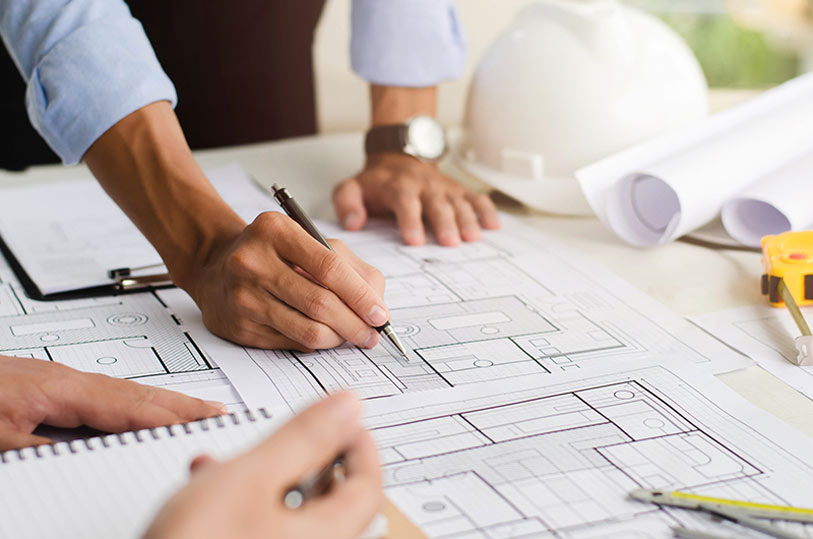The adventure of custom home design requires the expertise of both architects and designers. Architects provide a strong background in spatial design, combining creativity with technical expertise to assure structural integrity and safety. Their plans and drawings serve as the concrete foundation for a future custom home building, while thoughtful designers bring these spaces to life, paying attention to even the smallest details to match a client’s vision and desires.
They work together through the development phases, balancing aesthetics with usefulness and pushing the frontiers of innovation while staying within the budget associated with producing a dream home.
In this blog, we’ll look at how these experts play an important part in shaping the scope of architectural design.
Key Takeaways of Custom Home Building
- Architects and designers play a crucial role in home construction by combining individual vision with functional requirements.
- Architects must have an in-depth understanding of local regulations and a dedication to eco-friendly procedures
- Home design and construction are being revolutionized by cutting-edge technologies such as virtual reality and 3D modeling.
Understanding the Critical Role of Architects in Custom Home Building
The process of turning a custom home design from a dream into a reality relies mainly on the expertise of an architect. These professionals work at the boundaries of art and economics to create settings that are both functional and inspiring. Working closely with the builder, they take the time to capture the core of a client’s vision, translating their ideas into practical designs.
The architect’s responsibility extends beyond the drafting table, with a crucial position in the approval process and a constant presence during construction to ensure the integrity of their plans. From the first drawing to the last nail, the architect and designer’s influence is integral to the development of a house that is not only a home but also a work of art.
Establishing the Client’s Vision
When architects work with a customer, the first step is to carefully convert personal preferences into professional designs. This precise dance of imagination and concrete measurement ensures that every wall, window, and corner exactly complements the homeowner’s individual preferences.
From the sweeping arcs of a majestic staircase to the concealed pipes that make a home’s plumbing seamless, architects use their knowledge like an artist with a dream diploma. They listen, adapt, and imagine, creating not only homes but also the lives that unfold within them.
Verify Compliance With Local Construction Codes and Guidelines
Architects are an invaluable resource, carefully guiding the design and construction of custom houses through the difficult waters of regulatory compliance. These professionals work tirelessly to mitigate the impact of regulations on the client’s vision while carefully managing the project’s costs to stay within the agreed-upon budget.
Implementing Sustainable and Energy-Efficient Design Practices
Architects and designers don’t just make houses, but also foster a dynamic future through sustainable architectural engineering. They are skilled in using data to optimize energy use and build homes that make use of natural light and ventilation, reducing the need for artificial heating and cooling.
This commitment not only demonstrates a steward’s foresight but also assists homeowners in managing their money through lower utility expenditures.
Managing the approval process
- Once an architect has transformed a client’s concept into a concrete design, the next critical step is to navigate the complex approval procedure.
- Architects evaluate the site’s specific characteristics and design to guarantee compliance with local zoning and regulations.
- Collaboration with the city’s planning department begins, with blueprints being adjusted as needed to meet building codes.
- Throughout the process, architects argue for the client’s vision while intelligently managing the budget to create a home that not only meets requirements but also reflects the client’s desire.
- This approval process is more than simply a hurdle; it is a critical stage in which the home’s design is developed and prepared for building.
Supervising Construction to Maintain Design Integrity
An architect’s vigilance on a construction site, where the delicate balance of science and art is brought to life, protects the home’s architectural integrity. These professionals frequently collaborate with builders to ensure that the intricate elements of infrastructure and the flow of natural light within the space adhere to the energy efficiency and aesthetic harmony indicated in the original blueprints.
How Designers Improve the Custom Home Building Experience
Every square inch of a custom home is an investment and a statement. A designer’s touch can convert static drawings into dynamic, energy-filled houses. With a complete understanding of the client’s lifestyle, design aesthetic, and budget, experienced designers translate their client’s vision into the reality of their dream home. With a practiced eye, designers guide their clients in through the decisions required to choose every color and surface, wall to wall, floor to ceiling. Their expertise combined with cutting-edge technology allows a client to see every chosen component in every room in a 3-D rendering, ensuring the resulting construction meets every expectation.
Designing Interior Spaces to Suit Client Lifestyles
Interior designers use cutting-edge home technology and space management to create living spaces that are perfectly suited to their clients’ lifestyles and career needs. They use innovative climate-control technology to produce interiors that remain pleasant, ensuring that each room provides a calm backdrop for both work and pleasure.
Choosing Materials and Finishes that Reflect the Chosen Style
Designers are charged with choosing materials and finishes that honor the region’s legacy and climate. When contemplating the persistent heat in many places, decisions are frequently impacted by the need to supplement the efficiency of air conditioning systems, resulting in comfortable living areas.
This meticulous decision, led by the architectural vision and contract terms, assures not only aesthetic appeal but also practical longevity, which is heavily influenced by the elements and the constant hum of computer technology available to the designer.
| Material/Finish | Role in Architecture | Relationship with Climate Control | Contractual Consideration |
| Exterior Paint with Heat Reflection | Improves the appearance of the facade | Lessens the air conditioner’s cooling load | Sourced ethically in accordance with the agreement |
| High-performance Windows | Blends design with functionality | Lowers energy consumption | Specified for durability and efficiency |
| Native Landscape | Resonates with local style | Encourages natural cooling | Included in the layout of the site |
Emphasizing Practicality While Preserving Visual Appeal of the Custom Home Design
Architects and designers are skilled problem solvers, seamlessly combining functionality and elegance in each home they create. Engaging a landscape architect adds another layer to this complex process by expertly surveying and designing the home to blend in with its natural surroundings.
Furthermore, assistance from a structural engineer passes the practicality test, guaranteeing that the home’s base is as sound as it is visually appealing.
| Profession | Functionality Role | Contribution to Aesthetic Appeal |
| Architect | Blueprint creation that satisfies the client’s requirements | Transforming the vision into a beautiful, living design. |
| Landscape Architect | Assessing the land to ensure the best use | Creating outdoor areas that complement the house |
| Structural Engineer | Evaluating safety and structural integrity | Including structural components in the overall design |
Managing Client Expectations and Budget Constraints
In the dynamic process of designing a custom home design, architects and designers carefully balance customer aspirations with budget restraints. They tailor each construction design to match the desired aesthetics, use smart waste management to reduce unnecessary costs, and carefully communicate information to keep clients informed about every step toward the goal.
- The strategic use of resources guarantees that building design advances without budgetary overruns.
- Architects and designers interact frequently, providing the customer with precise information on material selections and design decisions that influence the overall aesthetics.
- Effective waste management methods are employed to reduce cost inflation and keep the project’s budget on track.
- Continuous alignment with the client’s vision is maintained in order to reach the ultimate aim of building a personalized home that fulfills their wants and preferences.
Custom Home Building Design Being Transformed by Technological Innovations
Modern technology has been utilized by architects to advance their designs. Skillful use of virtual reality and 3D modeling gives drawings life, enabling clients to tour their future homes before a single stone is placed.
These experts also include smart home technology, customizing homes to anticipate and address homeowner demands while delivering effectiveness, convenience, and security.
In addition to developing sustainable building methods to ensure that homes are not only aesthetically pleasing but also environmentally conscious, architects and designers are also pushing the boundaries of their profession as part of their ongoing commitment to professional growth.
These advances improve the homebuilding process and provide an extra safeguard against the uncertainties of the future housing market.
Using Technology in Smart Homes
By incorporating smart technology into construction and remodeling projects, architects are fusing sustainability into the very fabric of home design. By putting privacy first and maximizing harmony with the environment, these advances make sure that homes are not only smart but also considerate of the resources and space they occupy.
Cost-Saving Strategies Without Sacrificing Design Quality
Architects and designers use their natural creativity to come up with ways to cut costs without sacrificing the quality of the blueprint. Through the procurement of substitute materials that provide robustness and aesthetic appeal at a more affordable cost, they guarantee that customers obtain the best possible value.
Using locally sourced materials or coming up with creative custom home designs that use less resources without sacrificing the home’s structural or aesthetic integrity are two examples of strategies.
- Architects find more affordable, long-lasting substitute materials.
- They provide options for design that use less resources.
Conclusion
Architects and designers play an essential role in custom home building, blending creativity with technical expertise to bring a client’s vision to life. They ensure homes are functional, aesthetically appealing, and compliant with local regulations, all while embracing sustainable practices.
Through collaboration, technological innovations, and a deep understanding of client needs, they manage the balance between budget constraints and design integrity.
Together, architects and designers shape homes that not only reflect individual lifestyles but also stand as enduring testaments to modern efficiency, beauty, and environmental responsibility in the ever-evolving residential landscape.
At Renz Construction, we are known for our custom home building and remodeling services. Whether it’s kitchen and bathroom remodeling or garage, shed, and exteriors, we’ve got it all covered.
Our innovative remodeling designs have been the talk of the town as our company has been trusted by hundreds of clients for their custom homes and building projects.

